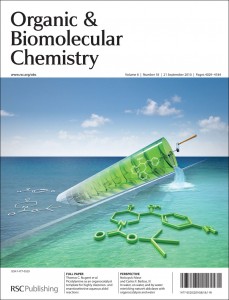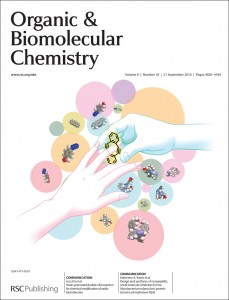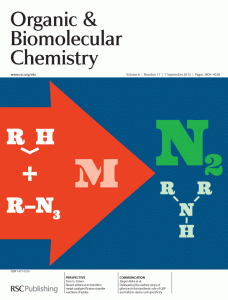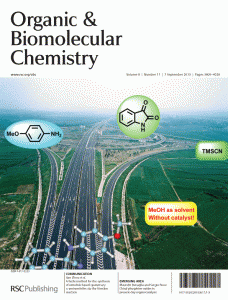This month sees the following articles in Organic & Biomolecular Chemistry that are in the top ten most accessed:-
Heterocycles in organic synthesis: thiazoles and triazoles as exemplar cases of synthetic auxiliaries
Alessandro Dondoni
Org. Biomol. Chem., 2010, 8, 3366-3385, DOI: 10.1039/C002586K
In water, on water, and by water: mimicking nature’s aldolases with organocatalysis and water
Nobuyuki Mase and Carlos F. Barbas, III
Org. Biomol. Chem., 2010, 8, 4043-4050, DOI: 10.1039/C004970K
Folding and self-assembly of aromatic and aliphatic urea oligomers: Towards connecting structure and function
Lucile Fischer and Gilles Guichard
Org. Biomol. Chem., 2010, 8, 3101-3117, DOI: 10.1039/C001090A
Nitrone protecting groups for enantiopure N-hydroxyamino acids: synthesis of N-terminal peptide hydroxylamines for chemoselective ligations
S. Irene Medina, Jian Wu and Jeffrey W. Bode
Org. Biomol. Chem., 2010, 8, 3405-3417, DOI: 10.1039/C004490C
Intramolecular Michael addition reaction for the synthesis of benzylbutyrolactones
Hu He, Li-Xin Dai and Shu-Li You
Org. Biomol. Chem., 2010, 8, 3207-3210, DOI: 10.1039/B924770J
Expedient, one-pot preparation of fused indoles via CAN-catalyzed three-component domino sequences and their transformation into polyheterocyclic compounds containing pyrrolo[1,2-a]azepine fragments
Padmakar A. Suryavanshi, Vellaisamy Sridharan and J. Carlos Menéndez
Org. Biomol. Chem., 2010, 8, 3426-3436, DOI: 10.1039/C004703A
Ultrafast Grignard addition reactions in the presence of water
Gyorgyi Osztrovszky, Torkil Holm and Robert Madsen
Org. Biomol. Chem., 2010, 8, 3402-3404, DOI: 10.1039/C0OB00170H
A three-step tandem process for the synthesis of bicyclic γ-lactams
Fiona I. McGonagle, Lindsay Brown, Andrew Cooke and Andrew Sutherland
Org. Biomol. Chem., 2010, 8, 3418-3425, DOI: 10.1039/C004695G
Total synthesis of decarestrictine I and botryolide B via RCM protocol
Palakodety Radha Krishna and T. Jagannadha Rao
Org. Biomol. Chem., 2010, 8, 3130-3132, DOI: 10.1039/C004556J
Picolylamine as an organocatalyst template for highly diastereo- and enantioselective aqueous aldol reactions
Thomas C. Nugent, M. Naveed Umar and Ahtaram Bibi
Org. Biomol. Chem., 2010, 8, 4085-4089, DOI: 10.1039/C0OB00049C
Why not take a look at the articles today and blog your thoughts and comments below.
Fancy submitting an article to Organic & Biomolecular Chemistry? Then why not submit to us today or alternatively email us your suggestions.











![C0OB00205D[1]](https://blogs.rsc.org/ob/files/2010/08/C0OB00205D1-300x76.gif)
![C0OB00214C[1]](https://blogs.rsc.org/ob/files/2010/08/C0OB00214C1.gif)
![C0OB00062K[1]](https://blogs.rsc.org/ob/files/2010/08/C0OB00062K1-300x117.gif)



